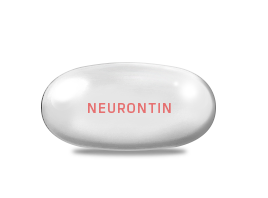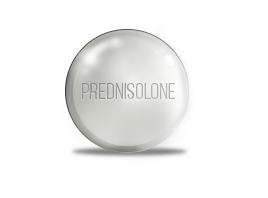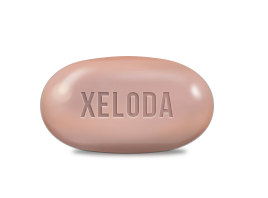An antimicrobial agent from the nitrofurans group, especially suitable for the treatment of urinary tract infections and prevention of infections after urologic surgery or examinations (cystoscopy, catheterization, etc.). The medicine disrupts the permeability of the cell membrane and protein synthesis in bacteria.

A symptomatic medication against vomiting and nausea of various origins. Used at vomiting caused by radiation therapy or cytotoxic drugs intake, hypotony and atony of the stomach and intestines, biliary dyskinesia, reflux esophagitis, flatulence, aggravation of gastric ulcer and duodenal gut, when performing contrast studies of the gastrointestinal tract. It reduces the moving activity of the esophagus, increases the tone of the lower esophageal sphincter, accelerates gastric emptying, and accelerates the movement of food through the small intestine without causing diarrhea. Stimulates the secretion of prolactin.

Methocarbamol – a muscle relaxant used to treat muscle spasms and pain. Its action is to block pain nerve impulses sent to the brain. The mechanism of action is not completely clear. The drug has no direct effect on skeletal muscles. It's likely that its effect is associated with sedative properties.

A thiazide diuretic of the average intensity, applied in arterial hypertension, edema syndrome of different origin, gestosis and diabetes insipidus. Reduces reabsorption of Na+ at the level of the Henle loop cortical segment, without affecting its segment lying in the medulla of the kidney that detects a weaker diuretic effect compared with furosemide.

Mobic is a nonsteroidal anti-inflammatory drug, which has anti-inflammatory, antipyretic, analgesic effect. It belongs to the class of oxicams; derived from the anoliefo acid. Used in symptomatic treatment of osteoarthritis, rheumatoid arthritis, ankylosing spondylitis (Bekhterev's disease) and other inflammatory and degenerative diseases, accompanied by pain syndrome.

A blocker of H1-histamine receptors of the first generation, derived from ethanolamine; eliminates the effects of histamine, mediated through this type of receptors. Promotes the local anaesthesia (when intaken, there is a short numbing of the mucous membranes in the mouth) - only in high doses, it blocks m-cholinergic receptors in the central nervous system, has sedative, hypnotic, antiemetic and antiparkinsonian effects. The therapeutic indications include: allergic conjunctivitis, allergic rhinitis, chronic urticaria, pruritic dermatoses, dermatographism, serum sickness.

An antituberculosis drug which acts bacteriostatically; it enters the actively growing cells of mycobacteria by inhibiting RNA synthesis, interferes with cellular metabolism, causing cessation of reproduction and death of bacteria. Active only in relation to the intensively dividing cells. Inhibits the growth and reproduction of tuberculosis mycobacterium resistant to streptomycin, isoniazid, PASK, ethionamide, kanamycin. In the conditions of monotherapy, the resistance of mycobacteria develops fast enough.

Prevents the occurrence of epileptic seizures, allodynia and hyperalgesia, and especially the pain response in different models of neuropathic pain. In addition,it reduces the pain response to peripheral inflammation, but does not affect the immediate behavior caused by pain.

The antifungal agent which has activity against dermatophytes, yeasts, dimorphic fungi and eumycetes. It is also active against staphylococci and streptococci. The therapeutical indications of the drug include: mycoses of the gastrointestinal tract, eyes, genital organs, chronic recurrent vaginal candidiasis, dermatomycosis, onychomycosis, Candida, folliculitis, dermatophytosis, systemic fungal infections (blastomycosis, candidiasis, paracoccidioides, coccidioidomycosis, cryptococcosis, histoplasmosis, hromomikoz, sporotrichosis, paronychia, fungal sepsis, fungal pneumonia); leishmaniasis; tinea versicolor, prevention of fungal infections in patients with a high risk of their development. The mechanism of action is inhibition of fungal membrane ergosterol synthesis and the violation of the cell wall permeability.

An antineoplastic, antiestrogen remedy. Used to treat breast cancer, mammary gland cancer, carcinoma in situ of the ductal breast cancer; endometrial cancer; estrogenconsisting tumors; adjuvant treatment of breast cancer. It inhibits estrogen receptors competitively in the target organs and tumors originating from these organs.

Nootropil improves cognitive processes, memory, attention, and mental performance.
Nootropilum affects the CNS, by changing the speed of propagation of the excitation in the brain, improves metabolic processes in nerve cells, improves by acting on the rheological characteristics of blood and causing no vasodilatory action.

An antimicrobial agent from the fluoroquinolone group. It has a broad spectrum of antibacterial action. The therapeutical indications include bacterial infection of the urinary tract (pyelonephritis, cystitis, urethritis), genitals (prostatitis, cervicitis, endometritis), gastrointestinal tract (salmonellosis, shigellosis), uncomplicated gonorrhea. Also used to prevent infections in patients with granulocytopenia, diarrhea of travelers.

A tricyclic antidepressant with a relatively short latency period. It has almost no sedative effect. therapeutical indications include: depressive phases of a manic-depressive psychosis, all other forms of endogenous depression (reactive and neurotic). In combination with amitriptyline it is used for depressions that occurred during treatment with reserpine. In combination with neuroleptics, it is used in the treatment of depression that developed during treatment of schizophrenic psychoses.

A tricyclic antidepressant with a relatively short latency period. It has almost no sedative effect. therapeutical indications include: depressive phases of a manic-depressive psychosis, all other forms of endogenous depression (reactive and neurotic). In combination with amitriptyline it is used for depressions that occurred during treatment with reserpine. In combination with neuroleptics, it is used in the treatment of depression that developed during treatment of schizophrenic psychoses.

Pamelor is a tricyclic antidepressant (TCA, tricyclic antidepressants) of the second generation. It is used in the treatment of some major depressive disorder and nocturnal enuresis (bedwetting) in children. In addition, the drug is sometimes used for the treatment of chronic diseases such as chronic fatigue syndrome, chronic pain and migraine, and the lability in certain neurological diseases.

The drug dilates coronary vessels (mostly arterioles) and causes a significant increase in volumetric blood flow velocity. Increases the content of oxygen in venous blood of coronary sinus and its absorption by myocardium. Promotes the development of collateral coronary circulation, reduction in a systemic vascular resistance, improves microcirculation, has angioprotective action.

Phenergan is an antiallergic, topical anesthetic, antihistamine, antipruritic, antiemetic, hypnotic, sedative on the basis of Prometnazine.

Prednisolone is a synthetic analogue of the adrenal cortex secreted by the hormones cortisone and hydrocortisone. Unlike cortisone and hydrocortisone, prednisolone does not cause a noticeable delay in sodium and water, and only slightly increases the release of potassium. The drug has a pronounced anti-inflammatory, antiallergic, anti exudative, anti-shock, antitoxic effect.

Blocks the final stage of HCl secretion, reducing basal and stimulated secretion, regardless of the nature of the stimulus. Prescribed for gastric ulcer and duodenal ulcer in acute phase, erosive-ulcerative esophagitis, reflux esophagitis, Zollinger-Ellison syndrome, stress ulcers of the gastrointestinal tract; eradication of Helicobacter pylori within a combination therapy, non-ulcer dyspepsia.

The drug is a prodrug and is activated in the acidic environment of the secretory tubules in the parietal cells. It reduces basal and stimulated secretion regardless of the nature of the stimulus. Prescribed in case of erosive ulcerative diseases of the gastrointestinal tract and eradication of Helicobacter pylori in infected patients with gastric and duodenal ulcer.

An antidepressant from the group of selective inhibitors of serotonin reverse capture. It has thymoanaleptic and stimulating effect. Improves the mood, reduces tension, anxiety and fear, eliminates dysphoria. Doesn’t cause sedation. When taken in high therapeutic doses, it virtually doesn’t effect the function of cardiovascular and other systems.

Antiemetic, which is a specific blocker of dopamine (D2) and serotonin receptors. It has antiemetic effect, eliminates nausea and hiccups. Reduces moving activity of the esophagus, increases the tone of the lower esophageal sphincter, accelerates gastric emptying and the movement of food through the small intestine without causing diarrhea. Stimulates the secretion of prolactin.

Septra - Sulfamethoxazole is an antibiotic that treats various types of infections caused by bacteria. The combination of sulfamethoxazole and trimethoprim is used to treat ear infection, urinary tract infection, prostate infection, bronchitis, travelers' diarrhea and pneumocystis pneumonia. The drug is available in the form of tablets, as well as in liquid form.

Sinemet - a combined remedy based on Levodopum + Carbidopum. In the treatment of Parkinson's syndrome and disease, Sinemet proved to be one of the most effective drug. The reviews are mostly positive, because it allows to reduce "inhibition" in patients who have been treated with other medications. For each patient, the dosage is selected individually, together with the frequency of admission.

Sumycin - An antibiotic based on tetracycline, a brand of such pharmaceutical companies as Bristol-Myers Squibb, Apothecon, Par Pharmaceutical.

Tegretol - anticonvulsant drug, dibenzodiazepine derivative. It also has neurotropic and psychotropic action. Indications for use: epilepsy, alcohol withdrawal syndrome, idiopathic trigeminal neuralgia and trigeminal neuralgia with multiple sclerosis (typical and atypical), idiopathic neuralgia of the glossopharyngeal nerve, diabetic neuropathy with pain syndrome, diabetes insipidus of central genesis,

is given to patients for treating severe acne that do not respond to other medicines

Tinidazole - an antibacterial agent for systemic intake, used for the treatment of diseases such as trichomoniasis, giardiasis, amoeba dysentery, anaerobic infection, mixed aerobic-anaerobic infections (in combination with appropriate antibiotics), prevention of postoperative anaerobic infections.

Topamax - the remedy with an active ingredient: topiramate, it is used as a monotherapy for the treatment of adults and children 6 years of age with partial attacks with or without secondary generalized seizures and primary generalized tonic-clonic seizures; as an adjunct therapy for the treatment of adults and children 2 years of age with partial attacks with or without secondary generalized seizures or primary generalized tonic-clonic seizures and the treatment of attacks associated with Lennox-Gasto syndrome; to prevent migraine attacks in adults, after careful evaluation of alternative treatment options. Topiramate is not recommended for the treatment of acute conditions.

Trandate - pills, mainly used in hypertension, it is an ideal means for lowering blood pressure.The rapid action of the active substance, Labetalol, distinguishes the drug from other similar drugs according to indications. The drug has the fastest antihypertensive effect.

Tricor - is a hypolipidemic agent, has an uricosuric and antiplatelet effect. In combination with diet therapy, the drug is prescribed for a long-term treatment, the effectiveness of which must be periodically checked by determining serum lipid levels.

Vantin - combined preparation, based simultaneously on 2 active substances: Cefpodoxime Proxetil. It belongs to the third generation of cephalosporins. Used to treat acute otitis media, tonsilitis, pharyngitis, respiratory tract infections, such as pulmonary pneumonia and chronic bronchitis.

Vasotec- an antihypertensive drug based on the action of the active ingredient Enalapril, whose mechanism of action is associated with inhibition of the activity of the angiotensin-converting enzyme, leading to a decrease in the formation of the vasoconstrictor factor - angiotensin II and simultaneously to the activation of the formation of kinin and prostacyclin possessing a vasodilating action.

Xeloda is a cytostatic drug. The drug is used for the treatment of patients with metastatic or locally advanced breast cancer, including after an ineffective chemotherapy course, which included anthracycline drugs and taxanes, and also if the patient has contraindications to anthracyclines.

Zantac - ranitidin - the drug is intended for the treatment of duodenal ulcers, benign gastric ulcer, postoperative ulcer, reflux esophagitis, Zollinger-Ellison syndrome, epigastric or chest pain. The administration of ranitidine is indicated in cases where a decrease in gastric secretion and a decrease in the production of hydrochloric acid is desirable, for the prevention of gastrointestinal bleeding, for the prevention of recurrence of bleeding in patients with bleeding ulcers of the stomach and duodenum, before general anesthesia in patients with a presumed risk of aspiration of acidic stomach contents (Mendelssohn syndrome), especially in women during childbirth delivery clashes.

Zebeta is a beta-blocker that affects the heart and blood flow. The drug is used to treat hypertension (high blood pressure)

Zithromax - antibiotic of a wide spectrum of action. Antibiotic-azalide, a representative of a new subgroup of macrolide antibiotics. In the focus of inflammation it has a bactericidal effect. For the active ingredient of Zithromax, Azithromycin, all the gram-positive cocci (except those bacteria which are resistant to erythromycin) are susceptible.

Zoloft is an antidepresant stopping the reuptake of serotonin, which is performed by the neurons that isolated it. As a result, the concentration of the neurotransmitter increases in the synaptic cleft and the main cause of depressive states, the serotonin deficiency, is eliminated.

is given to patients for treating severe acne that do not respond to other medicines

























